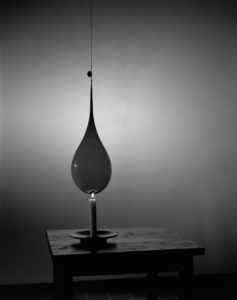Combining science with art can be shocking. Read to the end of this description of Molecular Geneticist-Turned-Artist David Goldes’s work to find out just how shocking it can be.
Explore the beauty and meanings of science by imagining artist David Goldes’s photography and videos:
The corner of an array of what looks like matches is ignited and the fire slowly spreads, eventually leaving charred, bent remains.
Magnetized pins on corks floating in water point north.
In a jar, water whirls in a tornado-like vortex, thanks to a magnetic stirrer.
Strings use capillary action to pull water from one pool to another.
A beachball-sized object launched into Earth’s orbit by the Soviet Union on October 4, 1957, a satellite known as Sputnik, inspired the United States to create NASA (the National Aeronautics and Space Administration) and increased interest in the sciences across the world. In Goldes’s words, there was “a lot of energy pushing kids into science in the early 60s.” Books by astrophysicist Carl Sagan and physicist Richard Feynman also inspired David. “Everyone wanted to read the red Feynman books, which were beyond understanding. They had these big white margins. I would drool over these books, but they were really tough.”
David built a transmitter and receiver in Brooklyn, when he was growing up. He operated a ham radio, learned Morse code, and communicated with people around the world. “For a 12-year-old, it was very exciting to be able to make a conversation of sorts with somebody in South Africa.”
After graduating from high school, Goldes studied biology and chemistry at the State University of New York, in Buffalo. He went on to seek a masters’ degree in molecular genetics at Harvard, where he studied with James Watson, who helped discover the structure of DNA. “The first year I was at Harvard was when students took over the administration building.” Eventually, “I realized that I wasn’t going to be one of those people, either the super-political or the Nobel Prize winner.” During the day, Goldes worked in a bacteriology lab. At night, he took classes at the Museum School. “The lab changed its name to molecular genetics. There’s fashion in science, just like in everything else.”
After getting his Master of Fine Arts, Goldes moved away from science for a while. But “in the last 20 years, my initial interests in and ideas about discovery, curiosity, and wonder reemerged.” The results, Goldes’s recent work, can often be seen at the Yossi Milo Gallery, in New York City.
His childhood experiments with electronics and radio led him to study the ways people learned about electricity. Humans first explored electricity with their bodies. Goldes read Benjamin Franklin’s letters to his friends in Europe about the experiments he suggested and King Louis XV of France tried (like the one you may have heard about, which involves flying a kite).

After learning from Humphry Davy that graphite is a weak conductor, Goldes began to create electrical circuits out of simple drawings. “If you draw a line and electrify it directly, you won’t see anything as the electricity goes through the line. To see it, I realized you have to interrupt the flow, cutting the line with a razor blade.” Goldes runs 15,000 volts of electricity through his lines, making them spark. “I make these drawings and let them burn…. I’m sure it has something to do with my interest in the ephemeral [moments which fly by], which is really the province of photography.”
Goldes’s friend, Electrical Engineer Michael Form, warned him that even touching insulated wire can be dangerous when working with thousands of volts of electricity. But the artist also learned first-hand how dangerous electricity can be. He collected batteries people in his neighborhood put out with their recycling and snapped them together to recover the electricity his neighbors had thrown away, a total of 500 volts. “I accidentally touched the two ends and a zap went right through me and burned my hands a little bit. I had a muscle spasm in my arms from the shock and that was the best part because as my arms shook, I threw the batteries all over the room, which broke the circuit.”
True to his scientist roots, Goldes experiments in his studio. He uses conductive paint, powdered graphite, and graphite pencils to create electric circuits. But some of the pencils disappoint him: “Some of the pencils called ‘graphite’ probably don’t have any graphite in them because they don’t conduct. I would make an elaborate drawing and nothing would happen.” As you can see here in “Small Jacob’s Ladder on Lined Paper,” however, plenty happens in Goldes’s art.
In addition to science and art, Goldes has always enjoyed math. “Calculus seemed very attractive to me because of its ideas about dealing with infinity and perfection.” He recommends the work of two artists who made and photographed models of mathematical equations: Hiroshi Sugimoto and Man Ray. A photographer himself, Goldes explains that “photography has this cross-over with science people, because there are photographers very interested in the optics of the process and in the instantaneous. How reality is described in various systems photographically: that is one version of reality.”


